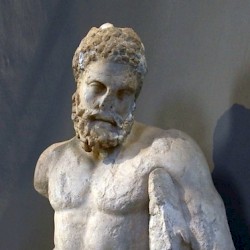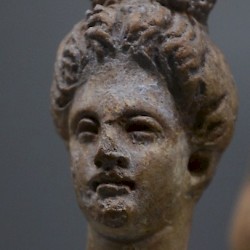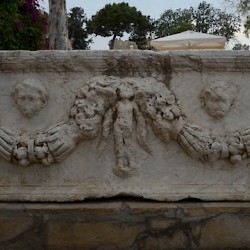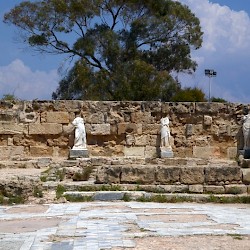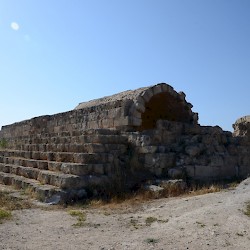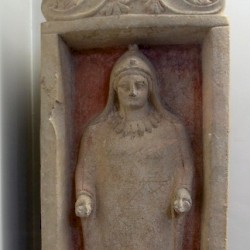Salamis (Cyprus)
Q767089Salamis (Greek Σαλαμίς): port on eastern Cyprus, just north of modern Famagusta.

Salamis is, essentially, the second of a series of three successive towns: the Bronze and Early Iron Age town Enkomi, ancient Salamis, and medieval Famagusta. Salamis was founded after Enkomi had been destroyed by an earthquake and would be abandoned in the age of the Arab conquests.
Dark Age, Archaic Age
According to legend, Salamis was founded by the Greek hero Teucer, who had been exiled by his father Telamon (king of the isle of Salamis in Greece) after he had been unable to recover the panoply of his half-brother Ajax, who had committed suicide during the Trojan War. There is nothing to confirm this story, which is probably based on nothing more than the similarity of the two names and a memory of the colonization of Cyprus by Mycenaean Greeks.

The oldest archaeological finds from Cypriote Salamis date back to the eleventh century BCE. Built around a natural harbor that must have served the needs of copper merchants, the town was inhabited by people who had left Enkomi. The new city is mentioned for the first time in an Assyrian text, in which king Esarhaddon (r.680-669 BCE) records the tribute he had received from the kings of Cyprus, including one “Kisu, king of Sillu'ua”.note The Royal Tombs, found between the ruins of Salamis and Enkomi, date back to this period.
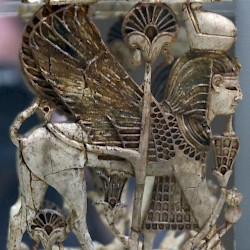 Salamis, Royal Tombs, Ivory |
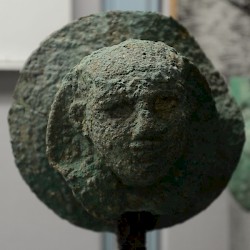 Salamis, Royal Tombs, Horse accessory |
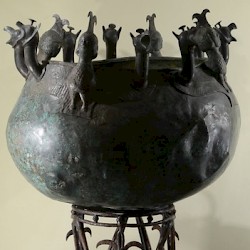 Salamis, Royal Tomb 79, Cauldron 1 |
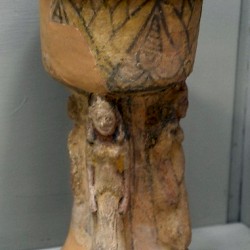 Salamis, Royal Tombs, Incense burner |

Classical Age
Like the other Cypriot kingdoms, Salamis had Assyrian and Egyptian overlords. The rule of the Persians would last two centuries, from the second half of the sixth century to 330 c. BCE. Occassionally, there were tensions. A revolt by one Onesilus, a member of the royal family, is mentioned by several authors, including Herodotus of Halicarnassus, but had no real consequences.
Hellenistic Age
After the death of Alexander the Great (in 323 BCE), his successors fought about possession of Cyprus (cf. the naval battle of Salamis in 306), which in the end became a Ptolemaic possession. There were two officials: the strategos (governor) and antistrategos (supervisor of the copper mines).
Roman Age

In 58 BCE, Salamis became Roman (under Marcus Porcius Cato Uticensis). The city was to benefit from Roman rule. Under the Empire, it flourished through trade, especially in wood and copper. It was certainly the island's greatest trade hub. The monuments you can visit today, date back mainly to the Roman age.
From the earliest times, Salamis' main god was Zeus, but his cult was of course not the only one. In the year 117 CE, the city was largely destroyed in the conflict between the Jews and the Romans but was rebuilt.
Constantia

In 332 and 342, many Cypriote cities were destroyed by heavy earthquakes. With the help of the Roman emperor Constantius II (r.337-361), the city was rebuilt on a smaller scale and renamed Constantia. It became the capital of Cyprus. One of the people living here was bishop Epiphanius, an important Christian writer. The Kampanopetra basilica dates back to this age.
Ammochostos
The end came when the city was destroyed by the Arabs around 650. The inhabitants moved to Arsinoe, a settlement further down the coast, just beyond Constantia's cemetery. Arsinoe had been founded by king Ptolemy II Philadelphus and had been named after his wife Arsinoe. Although a royal foundation, the town had declined and was just a fishing village. Many of the old buildings were covered by sand. It was nicknamed Ammochostos (Αμμόχωστος), which means something like "hidden in the sands". Today, it is called Famagusta.

